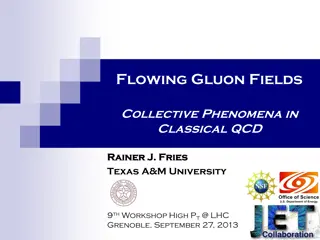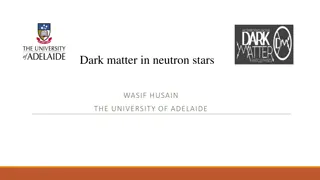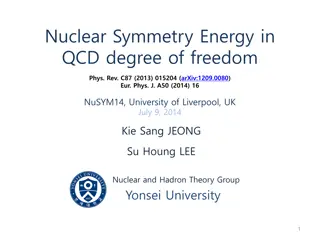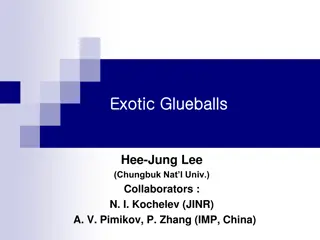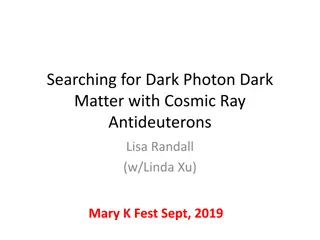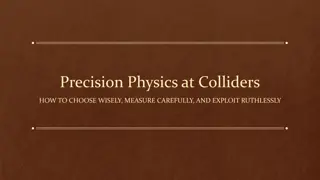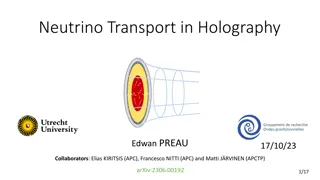Introduction to Chemistry: Matter, Energy, and Measurement
Chemistry is the study of matter, its properties, and the changes it undergoes. This content covers the basics of chemistry, including the classification of matter into pure substances and mixtures, different states of matter, and the building blocks of matter such as atoms and molecules. Sample exe
7 views • 51 slides
SCET: Effective Theory of QCD
SCET, a soft collinear effective theory, describes interactions between low energy, soft partonic fields, and collinear fields in QCD. It helps prove factorization theorems and identifies relevant scales. The SCET Lagrangian is formed by gauge invariant building blocks, enabling gauge transformation
1 views • 38 slides
Algebraic Solutions for Two-Dimensional Adjoint QCD
Two-dimensional adjoint QCD is explored with a basis-function approach aiming to achieve single-particle states over cluttered multi-particle states. The algebraic solution involves t'Hooft-like integral equations and pseudo-cyclicity considerations to address parton number violation and boundary co
1 views • 22 slides
Flowing Gluon Fields and Color Glass Phenomena in QCD
Explore the collective phenomena of gluon fields in classical QCD, focusing on the Standard Model of URHICs, Color Glass, and Gluon Fields in the Forward Lightcone. The research delves into topics like local thermal equilibrium, viscous hydrodynamics, and the interaction of probes with quarks and gl
0 views • 24 slides
Matter in Our Surroundings
Matter in Our Surroundings discusses the classification of matter, physical nature of matter, and the properties of matter particles such as size, space between them, and continuous movement. It explains how matter is made up of particles and how they interact with each other through various activit
0 views • 27 slides
Unveiling Dark Matter Mysteries Through Dark Photons
Delve into the exploration of dark matter through the lens of dark photons in the galactic center and detectors. Uncover the enigmatic nature of dark matter, its interactions, existing constraints, and our model with fermionic dark matter and a dark photon mediator. Discover strategies to evade cons
0 views • 18 slides
Quarkyonic Matter and Chiral Pairing Phenomena
Investigate the characteristics of quarkyonic matter and chiral pairing phenomena in the context of dense QCD at T=0. Delve into the confinement aspects, the properties of quarkyonic matter near T=0, and the candidates for chiral symmetry breaking. Consider the implications of chiral pairing phenome
0 views • 42 slides
Exploration of Critical Points in Quark Matter by Jasmine Brewer
Explore the theoretical perspectives on strangeness in quark matter as discussed by Jasmine Brewer from Oxford. The presentation delves into the search for the QCD critical point, dynamics of heavy flavor hadronization, and more, highlighting challenges and future opportunities in the field.
0 views • 21 slides
CP Violation in Low-Energy QCD: New Physics Perspectives
Investigating CP violation in low-energy QCD, this presentation by Sean Tulin from the University of Michigan delves into the sensitivities of decays to new physics, focusing on CP violation beyond the Standard Model and the potential existence of new weakly-coupled light forces hiding under QCD. Di
1 views • 37 slides
Dark Matter in Neutron Stars
Investigate the interaction of dark matter within neutron stars, comprising approximately 25% of the universe's total matter. The nature of dark matter assumptions, its distribution within neutron stars based on fermionic or bosonic properties, and the implications for self-interacting fermionic and
1 views • 22 slides
Nuclear Symmetry Energy with QCD Sum Rule
This study delves into the concept of nuclear symmetry energy through the lens of QCD Sum Rule, discussing its implications in Rare Isotope Accelerator Plan and nucleon-nucleus scattering. Utilizing mean field approximation and Borel transformation, the research aims to understand asymmetric nuclear
0 views • 21 slides
Exploring Transverse Momentum Distributions (TMDs) at the GDR PH-QCD Annual Meeting
The Annual Meeting of the GDR PH-QCD focused on discussing Transverse Momentum Distributions (TMDs) and their significance at small kT and small x values. Topics covered include gauge-invariant correlators, PDFs, and PFFs, as well as the utilization of color gauge links in describing partonic transv
1 views • 33 slides
Nuclear Symmetry Energy in QCD Degree of Freedom
Understanding the nuclear symmetry energy in the context of Quantum Chromodynamics (QCD) is essential for nuclear phenomenology. This study explores topics such as QCD sum rules, mean field approximation, and operator product expansion to decipher the energy properties of nuclear systems. The resear
1 views • 15 slides
Modification of Nucleon Spectral Function in Nuclear Medium from QCD Sum Rules
Investigating the modification of nucleon properties in the nuclear medium using QCD sum rules, focusing on hadron properties, mass spectrum, and chiral symmetry restoration. The study discusses the mass differences, non-perturbative contributions, and the analysis of QCD sum rule in nuclear matter.
0 views • 27 slides
Quark-Gluon Plasma and New State of Matter at High Energy Colliders
Delve into the realm of high-energy physics at nucleus-nucleus colliders, with a focus on the discovery of deconfined partonic matter and the investigation of parallel worlds. Explore the recent insights, emerging topics, and new phenomena observed in ultra-intense collisions. Uncover the properties
0 views • 35 slides
Mesons in Medium and QCD Sum Rule with Dim-6 Operators
Study of mesons in medium and their behavior using QCD sum rule with dim-6 operators, exploring mass shifts, broadening, and indicators of quark-gluon plasma. Specifically focuses on charmonium sequential dissociation and non-perturbative methods in QCD such as lattice QCD and Dyson-Schwinger equati
0 views • 27 slides
Exotic Glueballs and Hadrons in QCD Sum Rule
Delve into the world of exotic glueballs and hadrons through a review of QCD sum rule, investigation of light scalar mesons, and discussion on hadrons with unconventional quantum numbers. Learn about theoretical frameworks and calculations involving correlators, dispersion relations, Borel transform
1 views • 32 slides
Searching for Dark Photon Dark Matter with Cosmic Ray Antideuterons
Exploring the use of cosmic ray antideuterons for dark matter detection is a promising avenue in astrophysics. Antideuteron searches offer a low-background environment, making them ideal for detecting certain types of dark matter particles. Unlike antiproton searches, which face significant backgrou
1 views • 30 slides
Exploring the World of Matter and Elements
Matter is the physical "stuff" of the universe, encompassing elements that make up rocks, wood, air, metals, water, and living organisms. Chemical elements are the building blocks of matter, with essential elements like oxygen, carbon, hydrogen, and nitrogen constituting a significant part of living
2 views • 24 slides
Precision Physics at Colliders: Choosing Wisely, Measuring Carefully, and Exploiting Ruthlessly
Precision Physics at Colliders explores the selection, measurement, and utilization of data at colliders, focusing on fundamental symmetries and parameters of the Standard Model. The lectures cover topics such as QCD, top, electroweak, and flavor physics, emphasizing the importance of precision meas
1 views • 42 slides
Gray Matter in the Brain: Structure, Function, and Importance
Gray matter in the brain plays a crucial role in information processing and cognitive functions. Composed of neuronal cell bodies and unmyelinated axons, gray matter is visibly pinkish-gray and is essential for various brain functions. It forms a synaptically dense area with fewer cell bodies compar
1 views • 7 slides
Matter: States, Properties, and Changes
Matter is anything with mass and volume, existing in solid, liquid, or gas states. The Kinetic Molecular Theory explains the behavior of particles in matter. Chemistry explores matter through chemical and physical changes. Different factors, like temperature, can change the state of matter. Physical
0 views • 6 slides
Neutrino Transport in Holography Research Study
This research study delves into the realm of neutrino transport in holography, focusing on the interaction of neutrinos with dense QCD matter in the core. Motivations, formalisms, holographic set-up, and the holographic correspondence are explored using a toy model of quark matter in 4SYM and utiliz
1 views • 32 slides
Nature of Matter: Unit Project Overview
Embark on a journey to understand the structures and bonds of matter through a comprehensive unit project. Delve into atoms, molecules, compounds, pure substances, mixtures, phases of matter, properties, periodic table, and conservation laws. Explore matter classification and phase changes' relation
0 views • 9 slides
Introduction to Chemistry and Matter
Understanding chemistry involves studying the properties of matter and its changes. Matter is anything that occupies space and has mass, composed of vibrating atoms. It includes examples like air, water, books, desks, and people, while non-examples are light, sound, thoughts, and emotions. Physical
2 views • 18 slides
Collective Excitations in QCD Plasma: Hydrodynamic Regime Overview
This research presentation by Ali Davody and collaborators from Regensburg University explores collective excitations in QCD plasma, focusing on chiral hydrodynamics, magnetic and vortical waves, hydrodynamic excitation descriptions, and modes derived from kinetic theory. The study delves into the d
0 views • 33 slides
Dark Atom Effects on Structure Formation in the Universe
Overwhelming evidence points towards the existence of dark matter in the universe, with various theoretical models such as OHe atoms and Glashow's EIMP model proposed to explain its nature. Dark OHe atoms, consisting of 2 charged particles bound with primordial He nuclei, offer a unique perspective
1 views • 8 slides
K* in Dense and Hot Matter
Investigate the properties of kaons in various types of matter, such as dense nuclear matter and hot hadronic matter. Explore decay modes, probes for dense matter, and changes in kaon properties in dense matter. Analyze in-medium energy and kaon potentials. Study the influence of in-medium K+ potent
0 views • 21 slides
Properties of strange quark matter and strange star in a new mass scaling
Mapping the characteristics and mass scaling properties of strange quark matter and strange stars, revealing challenges in quantum chromodynamics (QCD) calculations and exploring thermodynamic treatments.
0 views • 18 slides
Semi-inclusive lepton jet function
Consider a world without QCD, where particles can be observed as non-singlets in an electroweak gauge theory. Explore the differences between QCD jet functions and leptonic jet functions, focusing on non-singlet contributions and the factorization of 2-jettiness using SCET. Address issues like rapid
0 views • 18 slides
String theoretic QCD axions in the light of PLANCK and BICEP2
This presentation discusses the implications of string theoretic QCD axions in the context of cosmological constraints. It explores the strong CP problem, axion solutions, physical properties of axions, and mechanisms for generating the axion scale. Issues such as the global U(1)PQ symmetry and astr
0 views • 22 slides
Pinning Down QCD Contributions to Flavour Anomalies
This study delves into flavour anomalies, exploring the implications of the observed deviations and the role of QCD effects. Through detailed analyses of transition matrix elements and dressed vertices, the investigation sheds light on the potential influence of new particles outside the Standard Mo
0 views • 11 slides
Understanding Matter in Our Surroundings
Explore the concept of matter and its classifications, physical nature, and particle characteristics. Learn how matter is composed of tiny particles with space between them and how they continuously move. Engage in activities to observe the properties of matter, emphasizing its presence in everyday
0 views • 32 slides
Superheavy Dark Matter from String Theory Insights
Exploring the concept of superheavy dark matter in the context of string theory, this study delves into the fundamental questions surrounding dark matter's nature, relic abundance, and implications for particle physics and cosmology. It highlights the role of string constructions in providing a comp
1 views • 19 slides
Understanding Changes in Matter: Exploring Composition and Transformations
Discover the composition of matter and its ability to change through engaging lessons and activities. Explore what matter is made of, how it can change, and examples of matter transformations. Enhance your understanding of science concepts related to matter with visual aids and interactive exercises
1 views • 10 slides
Color Confinement and Strong QCD Status Update for Hybrid Baryons Research
Explore the latest updates on research related to color confinement, strong QCD, and the search for hybrid baryons in Hall B. Details include studies on nucleon resonance structure, exclusive KY electroproduction, and deeply virtual Compton scattering using CLAS12 at varying energies. Get insights i
0 views • 11 slides
Understanding Soil Organic Matter and Its Importance in Ecosystems
Soil organic matter plays a crucial role in sustaining life in the soil, providing nutrients and energy to various organisms. This article explores the significance of organic matter for plant growth, decomposition processes, and ways to enhance organic matter content in soil. Discover the compositi
0 views • 11 slides
Quark-Gluon Dynamics in High-Temperature QCD Studies
Dive into the exploration of quark-gluon dynamics in high-temperature QCD studies. Discover insights on hadron disappearance, the success of HRG models for cumulants, and the transition to chiral states near critical temperatures. Detailed analyses of quark propagators, soft modes of chiral transiti
0 views • 22 slides
NLO QCD Corrections in Inclusive Bc* Production
Discover the NLO QCD corrections in inclusive Bc* production within Z0 decays, including background information on Bc mesons, direct and indirect production methods, motivation behind the research, calculation divergences, and IR in one-loop diagrams. Explore the latest advancements and theoretical
0 views • 16 slides
Bulk Viscosity Effects at Freezeout in Hot/Dense QCD Matter
Explore the impact of bulk viscosity at freezeout in hot/dense QCD matter through ideal and viscous hydrodynamics at the Nagoya Mini Workshop. Topics covered include quark-gluon plasma, Cooper-Frye formula, kinetic theory, and numerical results. The study highlights the importance of understanding t
0 views • 22 slides



